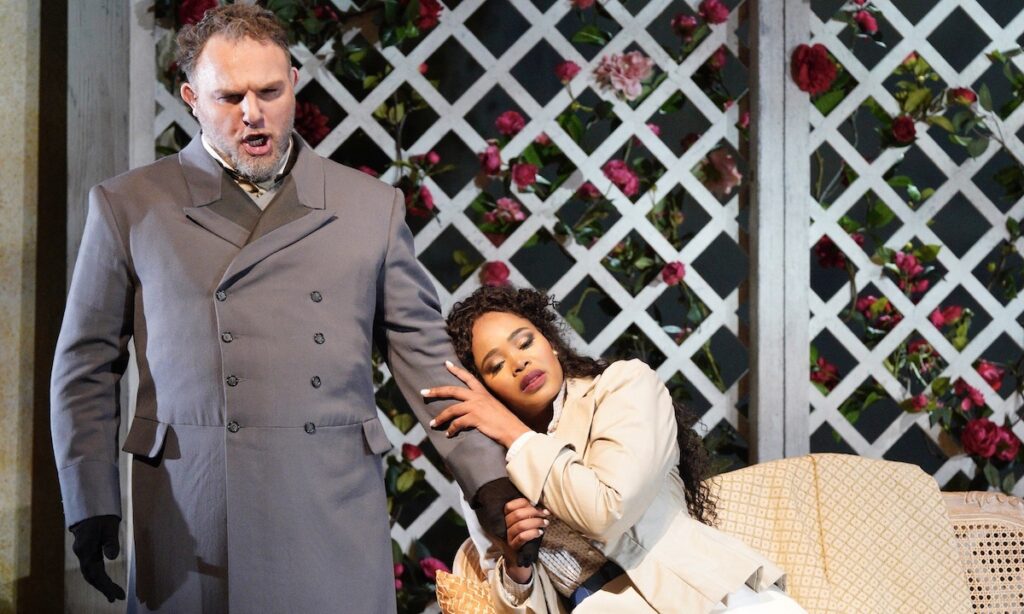Wondrous things do still happen at San Francisco Opera. Like the La traviata last night where conductor Eun Sun Kim built a perfect synergy with soprano Pretty Yende and tenor Jonathan Tetelman (lead photo), and baritone Simone Piazzola.
It Is the operatic ideal when the music actually becomes character, the composer’s genius absorbing the raw emotion, distilling the emotion into a voice that envelopes our senses and our intellects — in short the operatic ideal is the same as the Apollonian ideal. Verdi’s opera La traviata was such a voice just now, told by three singers who perused its nearly infinite range of emotions in telling their stories.
Conductor Eun Sun Kim established the measure — a firm beat except when it had to pause. Her beat did not often breathe, thus pushing the voices to move with or around the beat, capturing the immediacy and urgency of a moment. And there were plenty of these moments, in fact the entire evening was such a moment.
Conductor Kim’s orchestra [she is San Francisco Opera’s Music Director] sometimes competes with the stage for attention. But provide to her these singers who have the technique and musical importance to enter into her musical world, and her orchestra did indeed become one with the stage — in the intimate moments it was barely a whisper, and in the intense moments on stage is was all that was needed, no more. Her conducting was about measure, not about color — that was for the singers, and it too was largely about the rhythms of their words flowing through the conductor’s beat.
South African soprano Pretty Yende is surely the Traviata of the moment. She possesses a beauty of tone that exemplifies a virginal purity of emotion as well projecting sincerity of feeling. La Yende retains this purity and sincerity throughout her registers, from the softness and resignation in her lower voice in the third act “Addio, del passato bei sogni ridenti” to her sharp, full voice outbursts of rage in her midrange when she encounters Germont in Act II. From the intimacy of the discovery of her most intimate feelings in “È strano . . . ah! fors’è lui” to the flights of freedom in the stratospheric reaches of the soprano voice in “Sempre libera” (yes, she took the E-flat!).
La Yende is technically possessed by the role of Violetta, able to vocally realize every nuance of feeling in this complex fallen woman who tragically falls in love.

All photos copyright Cory Weaver, courtesy of San Francisco Opera
Alfredo’s father Germont was the domain of Italian baritone Simone Piazzola. Though young for the role (he is 37), he radiates a nobility of spirit in a unique baritone timber that resounds with tremendous authority and purpose. These attributes served him well as he established the god-given purity of his unseen daughter in the “Pura siccome un Angelo” and then cemented his parental authority by seeming to quietly demand rather than sing the “Di Provenza il mare” to the inexorable pulse of Eun Sun Kim’s Verdi baton.
American tenor Jonathon Tetelman brought big, beautiful Italianate voice to Alfredo. While the role does not offer Mr. Tetelman much (any) opportunity to thrill us with ringing high notes (he does sing Cavaradossi around the world) the role shone with a firm resoluteness of voice, rendering his love for Violetta as deep and sincere. His behavior at Baron Douphol’s party was therefore hugely disturbing, his anger at Violetta was wrenching. Finally, rather than soar to an emotional climax, Verdi asks him only to find the tenderness of his love. He sang his final duet with Violetta with his head buried in her bosom, the scene releasing an avalanche of emotion that overtook us all.
Of special note were the strong performances of Baron Douphol by Philip Skinner and the Flora of Taylor Raven, both roles firmly anchoring the happenings of the party scenes, the San Francisco Opera chorus was urged to extraordinarily spirited displays by conductor Kim, ever the showman.

It was a new production, staged by Shawna Lucey. Given the extraordinary musical elegance of the Verdi masterpiece by the conductor and principal singers the possibility of imposing any staging concept was nonexistent, or irrelevant. The larger chorus scenes unfolded in a sometime-in-the-19th century crass lasciviousness. The sets were well-designed generic recreations of 19th century looks, catering to the supposition that future audiences will always prefer period settings. Fortunately the sets will easily accommodate the use of other costume looks, and other stagings as future decades roll by — the previous Traviata production (John Copley) endured for three.
The sets and costumes were designed by Robert Innes Hopkins, lighted by Michael Clark. Choreography was by John Heginbotham.
Verdi’s overture was left unstaged.
Michael Milenski